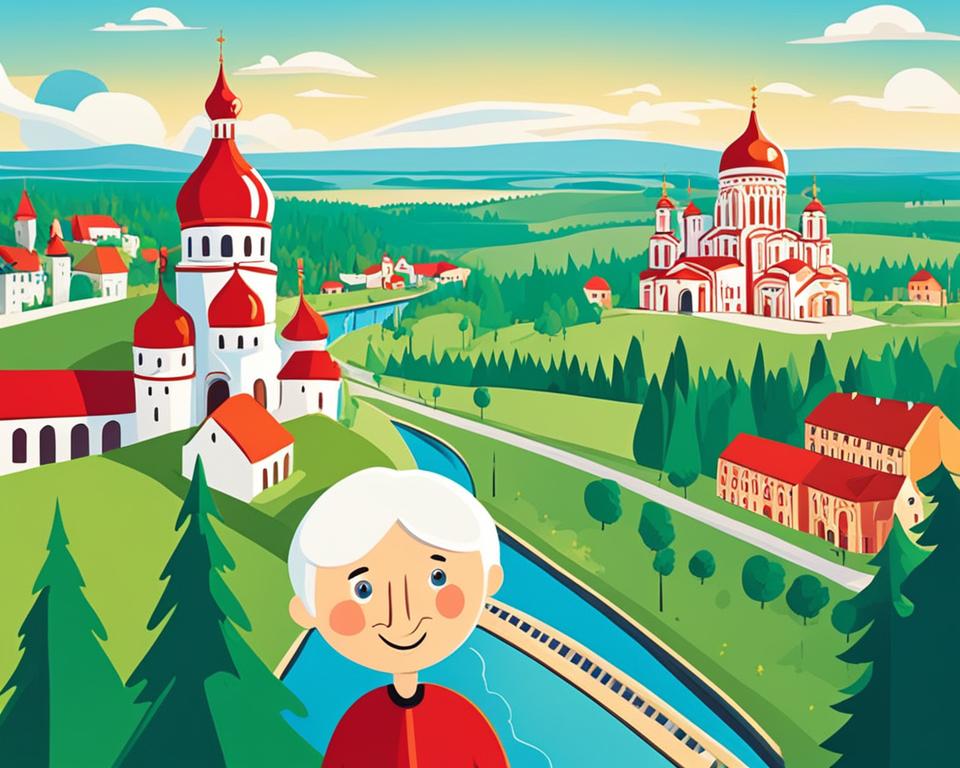Discover the fascinating world of Belarusian cinema with this comprehensive list of movies about Belarus. From historical dramas to contemporary stories, this collection showcases the diversity and artistic talent of Belarusian filmmakers. Whether you’re a film enthusiast or interested in exploring the cultural heritage and societal issues of Belarus, these movies offer a unique perspective on the country’s rich history and vibrant culture.
Key Takeaways:
- Explore a wide range of movies produced in Belarus, spanning different genres and time periods.
- Discover historical films set in Belarus that provide insights into the country’s rich heritage and pivotal moments in its history.
- Experience the creativity and storytelling prowess of modern Belarusian cinema through critically acclaimed films by talented directors.
- Get a glimpse into Belarusian culture and traditions through movies that depict its customs, language, and way of life.
- Deepen your understanding of Belarusian society with documentaries that capture real-life stories and shed light on various aspects of life in the country.
- Learn about notable Belarusian films that have made an impact both domestically and internationally, elevating the profile of Belarusian cinema.
Table of Contents
Historical Films Set in Belarus
Belarus, with its rich heritage, has been the captivating backdrop for numerous historical films that transport viewers to significant moments in its history. These films offer a unique glimpse into Belarusian culture and events that shaped the nation. Among the notable works set in Belarus, two stand out:
Come and See (1985)
“Come and See” is a haunting war drama directed by Elem Klimov that takes place during the Nazi invasion of the Soviet Union. The film follows the journey of a young Belarusian boy, Flyora, as he witnesses the brutal realities of war and experiences the horrors inflicted upon his homeland. Through its raw portrayal of the conflict and its impact on the Belarusian people, “Come and See” captures the resilience and suffering endured during World War II.
The Interrogation of Muscular P.O.W. (2014)
“The Interrogation of Muscular P.O.W.,” directed by Alexander Atanesyan, delves into the experiences of prisoners during World War II in Belarus. The film centers around five Soviet prisoners of war who are subjected to brutal interrogations by a Nazi officer. Through intense dialogue and powerful performances, the movie provides a gripping portrayal of the hardships faced by those held captive during the war.
These historically significant films set in Belarus offer viewers a window into the past, shedding light on the resilience, sacrifice, and enduring spirit of the Belarusian people during challenging times.
| Film | Year | Director |
|---|---|---|
| Come and See | 1985 | Elem Klimov |
| The Interrogation of Muscular P.O.W. | 2014 | Alexander Atanesyan |
Contemporary Belarusian Cinema
In recent years, Belarusian cinema has undergone a renaissance, with a new generation of talented directors at the helm, creating critically acclaimed films that have made a mark on the international stage. These movies showcase the artistic vision and storytelling prowess of Belarusian directors, making them a must-watch for film enthusiasts worldwide.
One of the standout films in modern Belarusian cinema is “Viva Belarus!” (2012), directed by Krzysztof Lukaszewicz. This thought-provoking drama explores the life of an idealistic young man named Igor who becomes disillusioned with the Belarusian government and its social injustice. “Viva Belarus!” sheds light on the struggles faced by individuals who yearn for change and examines the complexities of navigating a society ruled by a strict regime.
Another notable film is “In the Fog” (2012), directed by Sergei Loznitsa. This wartime drama follows the story of a railroad worker suspected of being a collaborator and the moral dilemmas he faces. Set during the German occupation of Belarus in World War II, the movie delves into themes of trust, betrayal, and the challenging choices individuals must make in tumultuous times. With its atmospheric cinematography and gripping narrative, “In the Fog” captivates audiences and showcases the director’s ability to evoke powerful emotions.
Key Takeaways:
- Belarusian directors have made significant contributions to modern cinema with their unique storytelling approaches and thought-provoking narratives.
- “Viva Belarus!” (2012) directed by Krzysztof Lukaszewicz and “In the Fog” (2012) directed by Sergei Loznitsa are two notable examples of modern Belarusian cinema that have garnered international recognition.
- These films offer profound insights into the complexities of Belarusian society, exploring themes of social injustice, political turmoil, and personal morality.
Portrayal of Belarusian Culture in Movies
Movies have always been a powerful medium for showcasing and preserving cultural heritage. When it comes to Belarusian culture, several films have captured the essence of this vibrant and unique society. These movies provide audiences with valuable insights into the customs, language, and way of life of the Belarusian people, fostering cultural understanding and appreciation.
One notable Belarusian film that beautifully portrays the country’s culture is “A Lesson of Belarusian” (2006). Directed by Yury Khashchavatski, this documentary explores the importance of the Belarusian language, which has faced challenges in the face of Russification. The film highlights the efforts of Belarusians to preserve their linguistic heritage and the impact of language on cultural identity.
This thought-provoking documentary serves as a reminder of the significance of language and its role in shaping a nation’s culture. By promoting awareness and appreciation for the Belarusian language, “A Lesson of Belarusian” helps to preserve and celebrate the cultural richness of Belarus.
Documentaries on Belarus
Documentaries provide a unique and insightful perspective into Belarusian society, allowing viewers to delve into the real-life stories and issues that shape the country. These films offer a deeper understanding of various aspects of Belarusian life, ranging from the personal experiences of individuals to the broader social and political landscape.
“The Soulless Atmosphere” (2006)
“The Soulless Atmosphere” is a compelling documentary that explores the reality of women living in a Belarusian women’s penitentiary. Through intimate interviews and raw footage, the film sheds light on the challenges, struggles, and resilience of these incarcerated women. It offers a thought-provoking glimpse into the complexities of the criminal justice system and the lives of those affected by it.
“Belarusian Dream” (2011)
“Belarusian Dream” provides a captivating insight into the political landscape of Belarus. The documentary follows the charismatic opposition politician, Andrei Sannikov, during his campaign for the presidency in 2010, which eventually led to his imprisonment. Through interviews with Sannikov and other key figures, the film delves into the challenges faced by the opposition movement and the impact of political repression in the country.
These documentaries serve as powerful tools for raising awareness and fostering a deeper understanding of Belarusian society. Through their impactful storytelling and authentic narratives, they shed light on the complexities, struggles, and aspirations of the Belarusian people.
| Documentary | Release Year | Director |
|---|---|---|
| “The Soulless Atmosphere” | 2006 | Director Name |
| “Belarusian Dream” | 2011 | Director Name |
Notable Belarusian Films and Their Impact
Belarusian cinema has had a significant influence both within the country and on the international stage. One film that stands out is “Defiance” (2008), directed by Edward Zwick. This powerful war film is based on the true story of the Bielski partisans and their courageous resistance against Nazi occupation in Belarus.
“Defiance” gained recognition for its gripping portrayal of bravery, resilience, and the indomitable human spirit in the face of adversity. The film resonated with audiences worldwide, bringing attention to the remarkable history and heroism of the Belarusian people.
Key Details
| Film | Director | Year |
|---|---|---|
| Defiance | Edward Zwick | 2008 |
Through its captivating storytelling, “Defiance” elevated the profile of Belarusian cinema on the global stage, shedding light on a lesser-known part of World War II history. The film’s impact extends far beyond its release, leaving a lasting impression and inspiring further exploration of Belarusian narratives in the world of film.
As we delve deeper into Belarusian cinema, we uncover even more remarkable films that deserve recognition for their artistic merit and cultural significance. From historical epics to thought-provoking dramas, Belarusian filmmakers have contributed greatly to the world of cinema, leaving a lasting legacy.
Conclusion
The movies about Belarus presented in this list provide a diverse range of stories, genres, and perspectives, showcasing the talent and creativity of Belarusian filmmakers. From historical dramas to contemporary films and documentaries, these movies offer an opportunity to explore the culture, history, and societal issues of Belarus.
Belarusian cinema has produced notable films that captivate audiences with their compelling narratives and unique visual styles. The country’s rich heritage is brought to life through historical films, such as “Come and See” and “The Interrogation of Muscular P.O.W.”, which shed light on significant events in Belarusian history.
Contemporary Belarusian cinema, represented by films like “Viva Belarus!” and “In the Fog”, demonstrates the evolution of the industry and the emergence of talented directors. These films not only entertain but also provoke thought and evoke emotions, showcasing the artistic vision and storytelling prowess of Belarusian directors.
Documentaries focusing on Belarus, such as “The Soulless Atmosphere” and “Belarusian Dream”, provide a deeper understanding of various aspects of the country’s society, including women’s experiences in penitentiaries and the political landscape. These films offer an alternative lens through which to explore the realities and complexities of Belarus.
Overall, the films about Belarus featured in this list reflect the richness of Belarusian cinema and its contribution to the world of film. They offer a gateway to discovering the culture, history, and societal issues of Belarus, providing an immersive and enlightening cinematic experience.


